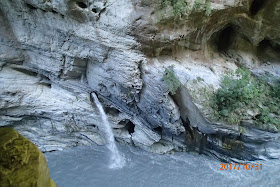 |
| After a simple breakfast at Liwu Hotel we then checked out and moved to Hong Ying B&B next door to join the others for another night in Taroko. Thank you Liwu for your lovely hospitality. |
 |
| Hong Ying B&B in the morning of our second day in Taroko. |
 |
| The weather was absolutely different from yesterday. It has a clear and blue sky with such a wonderful weather for Day 2. Jo has just visited 7-11 to buy some food stuff for the day's outing. |
 |
| The plan was to to hike a few trails in Taroko and travelling to this places by bus. We were ready to hike and the bicycles can have a good rest at Hong Ying. |
 |
| While waiting for the bus to come, a cute cat came entertaining us. |
 |
| The first trail was to tackle Shakadang Trail located at GPS : 24.162066, 121.613737 where I was standing on Shakadang Bridge which is part of the Central Cross-Island Highway. |
 |
| At the entrance of Shakadang Trail where we have to walk down a staircase to the trail. |
 |
| The estimated distance of the trail we was 1.5km one way and coming back on the same route. |
 |
| The Shakadang Trail (砂卡噹步道) is also known as “Mysterious Valley Trail”. |
 |
| Shakadang Bridge with red painted arch and concrete balutrade railing with small cute guardian lions on top. |
 |
| It has crystal clear turquoise water with scattered broken boulders on the bed. The view is awesome. |
 |
| This trail is easy and is suitable for all ages and once should try to visit it. |
 |
| Another view of the crystal clear Shakadang River as you can feel the wind blowing through the marble canyons and boulder strewed at the riverbed. |
 |
| How nice if we could get closer to the water and dip our legs in it. |
 |
| Though it is an easy walk taking about 2 hours round trip with a little elevation but make sure to watch your head when passing under overhanging rock surfaces. |
 |
| The total length of Shakadang Trail is about 4.4km which we were only doing one length of it from Shakadang Bridge. |
 |
| Looking closer to the marble formation with distinguish strata layers on the canyon wall and the crystal clear blue water. |
 |
| I noted a cave opening where the river water runs into it. |
 |
| The entire trail is protected with a railing, though you cannot see any guards around but one has to be careful when walking in the trail. During wet season the rocks on the ground can be slippery. |
 |
| We jumped into another bus for our second trail and it was Swallow Grotto Trail 燕子口步道. Located at GPS : 24.173167, 121.565868 |
 |
| A picture with Jhuilu Suspended Bridge, the one in green in colour at Swallow Grotto Trail Entrance. |
 |
| The trail is safe to visit of about half kilometre and vehicular traffic is careful with visitors and have to move very slowly if they are using this old road. |
 |
| Due to erosion and natural disaster the gorge has transformed and caused pot holes found at the walls with spring water gushing out of the holes. |
 |
| It's truly amazing, walking at the edges of the cliff and enjoying the magnificent views of the gorge. |
 |
| One has to slowly walk the trail and carefully observe the various features found in the place. I missed the Indian Head. |
 |
| We met two Brommies from Hong Kong enjoying their visit with their folding bicycles. |
 |
| Long long time ago during the ancient time these tunnels were dug by hands to form part of the trail and today it's a marvel we could still use it. |
 |
| Following the trail at Yanzikou (Swallow Grotto Trail) we could see more rock cliffs of the Liwu River with the river water flowing swiftly between the narrow gorge walls. |
 |
| Concrete structure of such are seen to strengthen the cliff and provide safety to visitors. |
 |
| Jo was about to enter a dark tunnel of Lushui Trail (綠水步道). |
 |
| The dark and narrow tunnel. It was only a short spell of total darkness if not one has to carry a torch. |
 |
| Lushui Trail (綠水步道) is a well maintained and easy to hike which is suitable for all ages. |
 |
| It takes around one hour to finish the 2km trail. This scenic path features forests, cliffs, a variety of plant species, and traces of the Japanese occupation period. |
 |
| Lushui Trail was part of the Old Cross-Hehuan Mountain Road during the Japanese colonial era. |
 |
| We took our lunch at a restauraunt for a simple meal of economy rice "chap fun" immediately when we alighted from the bus. |
 |
| We ended the day with our dinner at Hong Ying B&B with their home cooked meal. The food was good and delicious. Good night Taroko. Photo Credit : Anne Cheong. |






No comments:
Post a Comment